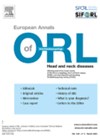
Journal Reviews
Septoplasty revisited
Septoplasty is one of the commonest rhinological surgeries performed. With the advent of minimally invasive surgical concepts, endoscopic targeted septoplasty was introduced. This study aimed to compare the complications and outcomes between endoscopic septoplasty and conventional septoplasty by a PRISMA...
Effects of diet and exercise on tinnitus
Subjective tinnitus is the perception of sound without any external stimulus. There is no consensus on the aetiology of tinnitus. Obesity is one condition that has been associated with subjective tinnitus. The authors conducted a randomised controlled trial to assess...
Are there any benefits of postoperative antibiotics after endoscopic transsphenoidal surgery for pituitary tumours?
This prospective randomised double-blind multicentre study evaluated whether postoperative antibiotics resulted in improvement in sinonasal quality of life (QoL) compared to placebo in patients undergoing endoscopic endonasal transsphenoidal pituitary surgery. A total of 461 patients were screened for the study...
Quality of life after cochlear implantation in the older population
Cochlear implants (CI) have been increasingly adopted in older adults with severe to profound hearing loss as a result of the growing and ageing world population. There is much interest in the cost-effectiveness and quality of life in CI users....
The effects of paediatric tracheostomy
Paediatric tracheostomy is usually an essential procedure to preserve life, or to allow a patient to function in the community. However, the effect of tracheostomy on the developing child - care requirements, lack of voice, impaired swallow, constant risk of...
Long-term voice outcomes following transoral laser surgery versus radiotherapy for early laryngeal cancers
The oncological outcomes of transoral laser microsurgery (TOLM) for early laryngeal cancers are well-known to be very similar to radiation therapy (RT). The functional outcomes associated with each treatment modality are therefore of significant interest. This study is reported to...
The paediatric dilemma of one ear in and one ear out of NICE criteria
The auditory implant team in Manchester have implanted a cohort of children where audiological thresholds meet the NICE guidance for cochlear implantation (CI) in one ear only, and the other falls into moderate, severe or sloping loss. These children are...
Are there benefits of prophylactic swallowing exercises for patients with head and neck cancer?
This randomised controlled trial aimed to establish the impact of prophylactic swallowing exercises in patients undergoing chemoradiation therapy for head and neck cancer. The primary outcome was the functional oral intake scale (FOIS), although secondary measures for feeding tube use,...
How useful is AHI?
There is a growing unease in the sleep medicine world about the usefulness of the apnoea-hypopnoea index (AHI). Most of our objective evidence about obstructive sleep apnoea (OSA) is in some way related to the AHI, and the respiratory physicians...
Do implants assist rehabilitation following mandibular reconstruction?
When undertaking mandibular reconstruction, optimal function and aesthetic rehabilitation is the goal. There is no doubt that patients consider chewing, swallowing and speech to be of paramount importance. Following surgery, suboptimal rehabilitation leads to a fall in quality of life...
Day care stapes surgery
This paper reports on a proposed unblinded, randomised controlled trial in which the hearing outcomes after inpatient stapes surgery will be compared with those after day case stapes surgery. The study is currently in the recruitment stage and plans to...
















